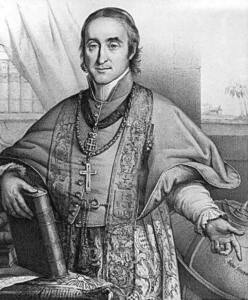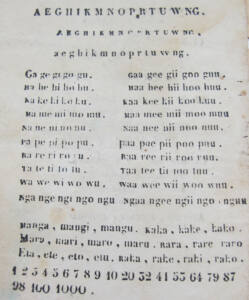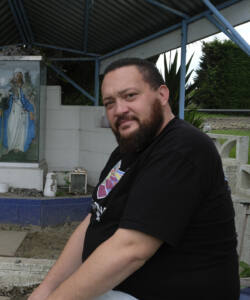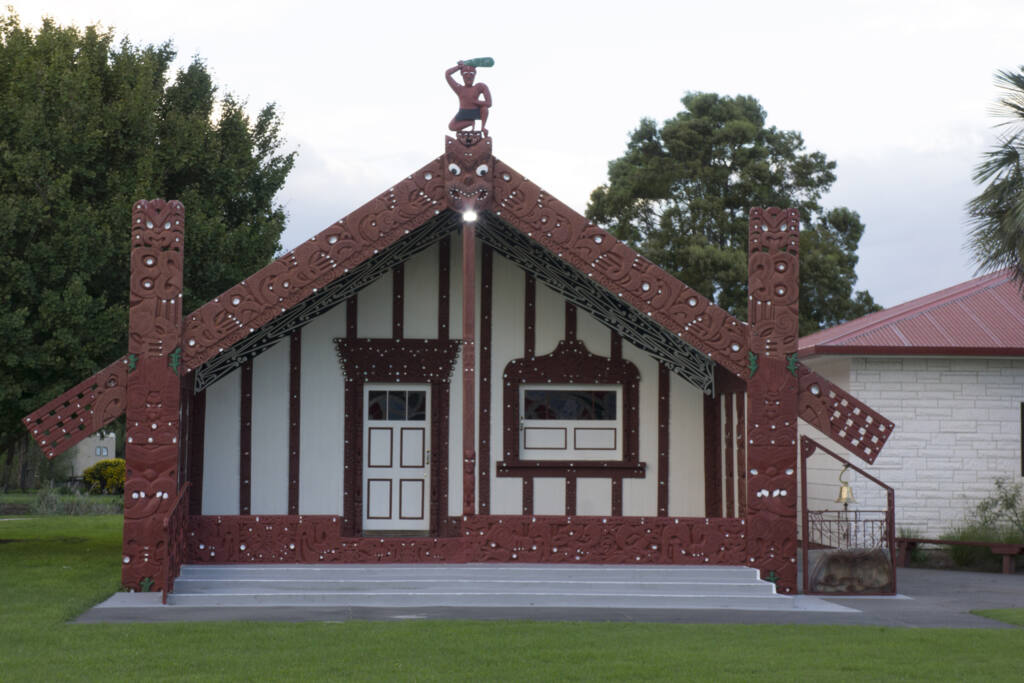
WelCom, September 2024
Ake Ake Ake – A Forever Language
Every year since 1975 New Zealand has marked Māori Language Week as a time for all New Zealanders to celebrate te reo Māori – the Māori language – and to use more Māori phrases in everyday life. In 2024, Māori Language Week runs from 14–21 September.
“The New Zealand Catholic Bishops’ Conference wants the liturgy of the universal Church to be inculturated in this land and to reflect the distinctiveness of New Zealand, and therefore have encouraged the use of some te reo Māori for all congregations.”
Te Reo Māori in Catholic Liturgy in Aotearoa New Zealand

Fr Mervyn Duffy sm
The Māori language has been in use in Catholic Liturgy in New Zealand since at least 1840. French missionaries taught hymns and prayers in te reo Māori to their Māori converts. The hymn, Mō Maria, was composed by Bishop Pompallier and printed in 1843. In general, te reo and Latin were used by Māori congregations on what was referred to as ‘the Māori mission’ and Pākehā congregations used English and Latin.
With the introduction of the vernacular liturgy after the second Vatican Council, the prayers of the Mass were translated from Latin into English and Māori. The English Missal contained no Māori and vice versa. These liturgical language worlds existed side by side with little mingling. An ordinary parish Mass would be entirely in English with English hymns, and the rarer Māori Masses would be largely te reo.
In the 1970s the Liturgical Sub-Committee of the Christchurch Diocesan Pastoral Council published a hymn book called Tenei Matou (Here we are together) which contained about 115 items, 106 in English, eight in te reo and one in Hebrew. Two verses of Mō Maria were included.
In 1981 the ‘national liturgical music book’ Sing Praise was produced by Mgr Charles Cooper. According to his introduction, 14 per cent of the texts are Māori, selected by the New Zealand Māori Liturgical Commission. All 14 verses of Mō Maria are included.
In 2010, when the English translation of the Roman Missal was changed worldwide, the New Zealand Catholic Bishops’ Conference chose to publish a bi-lingual edition of the Roman Missal in English and Māori. Celebrants now have both languages on the page in front of them.
All of this was in the context of a revitalisation of the Māori language in New Zealand. A 1972 petition to Parliament urged the government to provide teacher training to enable Māori language to be taught in schools. In 1987 the passing of the Māori Language Act made Māori an official language of New Zealand and established the Māori Language Commission. The first Kōhanga Reo (‘language nests’) were begun in 1981, by 1993 there were 14,027 children attending 809 kōhanga. In 1987 the first dedicated Māori language radio station began broadcasting full time. Māori Television began broadcasting nationally in 2004.
In public events in New Zealand, it is now normal to hear te reo Māori. National Radio announcers incorporate it in their introductions and conclusions. All children are introduced to some Māori language and waiata in primary schools. It is part of the formalities in secondary and tertiary education. Our national anthem is sung in both English and Māori. We take pride in the All Blacks’ haka. New Zealand English has a remarkable number of gain words from Māori.
The New Zealand Catholic Bishops’ Conference wants the liturgy of the universal Church to be inculturated in this land and to reflect the distinctiveness of New Zealand. They have therefore encouraged the use of some te reo Māori for all congregations.
Mervyn Duffy sm is Dean Good Shepherd College – Te Hepara Pai | Te Kupenga – Catholic Theological College.
Pompallier, the missionaries and Te Reo
Fr Mervyn Duffy sm
The missionaries from France came to New Zealand in 1838 to evangelise the ‘New Zealanders’ – the Māori of Aotearoa. These first Catholic missionaries were religious priests and brothers accustomed to a routine of liturgical prayer in Latin – the Mass and the Office – and of devotional prayer in their native French, but they learned the language of the Māori and translated the Catholic prayers into te reo and composed hymns and chants in the same language.
In 1842, Br Pierre-Marie Pérénon wrote to the General of the Marist Brothers, Br François Rivat, telling him of his impression of the Māori and a little about what they are teaching them:
All the natives smoke pipes, men, women, and children. They go barefooted and bareheaded, but they cover their bodies. They have lost many of their barbarous habits since they have been mixing with Europeans. […] Their memories are good and they learn by heart everything they want to. It is very edifying to see them make the sign of the cross or to hear them respond to the prayers and sing the hymns. Almost all of them know how to read and write. They love their books. The place where we live in New Zealand is called the Bay of Islands and the town is called Kororareka.
The missionaries comment frequently on the Māori ability to quickly learn prayers, hymns and catechism. They have the memory skills of people raised in an oral culture, yet there is a new widespread literacy and a desire for reading materials. Protestant missionaries were teaching reading, but it spread well beyond the mission schools. Māori were teaching Māori to read in te reo.
The teaching of prayers, hymns, and catechism in te reo was the catechesis being provided by the missionaries. They were teaching the Māori to pray, and the prayers were devotional prayers in Māori rather than Latin liturgical prayer. The first prayers taught were the sign of the cross, the ‘Our Father’, the ‘Hail Mary’ and the ‘Creed’.
Even when the Eucharist was being celebrated the congregation was more likely to be praying in te reo. Fr Auguste-Joseph Chouvet, whilst complaining to Fr Jean-Claude Colin about the poor relationship between him and Bishop Pompallier, mentioned that the bishop ‘said the Mass for the natives, and was unwilling for me to assist him, even having the natives’ prayers during the holy sacrifice led by a native.’ This gives us a glimpse of a liturgy being celebrated by the bishop, while the congregation are led in devotional prayers. The Māori attended the Mass but in the days before dialogue liturgy were not expected to verbally engage with it and, being catechumens, they would not have received communion. Being present, and praying along with the Mass was the expected behaviour.
Br Claude-Marie (Jean-Claude) Bertrand describes the dynamic to Br Rivat:
I see these fine New Zealanders coming in their canoes to assist at the divine mysteries of our holy Faith, saying their prayers and singing the hymns the Fathers have composed for them in their own language!
Prayer, karakia, and chants, were already part of Māori culture. The innovation brought by the Catholic missionaries was a new set of prayers, not the idea of prayer. Fr Forest tells Fr Colin about a missionary trip in the very Catholic region of Ōpōtiki:
We continued on our way reciting the prayers in Māori, and chanting the litanies of the Blessed Virgin. We formed two choirs, Fr Reignier and one of the natives chanting the invocation e hata Maria etc [Hail Mary], the other Māori and I chanting the response inoi mo matou, ‘pray for us’. We experienced a joy impossible to express in being able to mingle these consoling chants to the Queen of Heaven with the sound of the foaming breakers dying at our feet.
Towards sunset we came to a Māori pā containing about thirty people, twenty-four of them Catholic and following the prayers of epikopo.
The ‘prayers of epikopo’ are the prayers introduced by Bishop Pompallier. Epikopo is a Māori gain word based on the Latin for ‘bishop’: episcopus.
Bishop Pompallier instructed his missionaries to not demand that Māori dress in European clothing to come to Church.
Take care that those who turn to the true Church are not seduced by false reasoning and that they are not ashamed to come to prayers in their native dress. God does not require European dress from those who want to serve Him – He wants our hearts and that is all. As regards our bodies, He wants us to dress modestly, whatever our clothing. It is better to go to Heaven having worn native dress, than to go to Hell in European clothing.
The Catholic faith was first communicated to the ‘New Zealanders’ in their own language. The first Catholic publications were entirely in te reo. Māori worshipped in native dress and in their native language.
The first New Zealand Catholic publication
When Bishop Pompallier, Fr Catherin Servant and Br Michel Colombon arrived in Aotearoa New Zealand in January 1838 they encountered a Māori population with a hunger for the printed word.
When they evangelised a village, they taught the people Catholic prayers in te reo, so they could recite these prayers at dawn and dusk. Initially they copied these out by hand. Fr Pezant wrote back to Fr Epalle requesting more writing supplies:
Ordinary writing paper: you gave me a lot, but I use a lot of it, not so much for myself as for the kaingas; their prayer books have 50, 60 pages, and they keep me very busy in the midst of errands and repairs. Some good ink. I use a lot of it, for the same reasons.1
The missionaries wanted a printed version of the prayers. Before the press arrived for the Catholic mission, Pompallier succeeded in getting an eight-page pamphlet printed.2 William Colenso, wrote in the records of the Church Missionary Society for 14 January 1840:
I send you in the parcel one of the R C Bishop’s books, […] This little book now sent is the only one which the R C Bishop has yet published, I doubt not but that he is busily engaged in preparing others, for he is an active man.3
Pompallier had seen examples of Protestant publications in Māori and knew what was popular. His first printed leaflet was to address the Māori desire to learn to read and to provide the Catholic prayers which were so much effort to handwrite.
Ko Nga Tahi Pono Nui O Te Hahi Katorika Romana (The First Great Truths of the Roman Catholic Church) starts off on page 1 and 2 with a list of six teachings. The first: ‘1. There is only one God; For God is a very great spirit, for everything is from him, and he did make all the creatures alive all this time. There are three persons in God, the Father, the Son, and the Holy Spirit. And there are not three gods, but there is one God only, and he is spirit.’ Then on page 3 the Apostles’ Creed, page 4 the Our Father, the Hail Mary and the Sign of the Cross. On pages 5 – 7 there is a long hymn (15 verses) ‘He Waiata Tapu I Te Atua’ teaching the attributes of God.

Then on page 8 is the selling point:
This may not look like much to us, but to a literate Māori it was everything needed to teach another Māori speaker how to read the printed form of the language. The fifteen letters of the alphabet (taking NG as a single letter) in upper and lower case. A practice with the short and long vowel sounds – using the double letter rather than a macron or an accent. Then some example words and then the numerals and some example numbers.
The student would chant and memorise the information on the page. Since Māori is pronounced as it is written (unlike English) once you know the noise a letter combination makes you can sound out any written word and recognise it. Learning just this page enabled a fluent Māori speaker to gain the skill of reading text printed in Māori. They weren’t therefore able to write, nor to read handwriting, but they could read printed matter.
The first printed matter available to them to read was the rest of the pamphlet, so they very quickly learned the prayers and the hymn. Then the booklet could be passed to another person and so on.
Initiated by the Protestant mission school, and then by a Māori-to-Māori dynamic an entire generation taught themselves to read. The mission presses were the first to respond to their demand for reading materials. In 1842 the government began Ko te Karere o Nui Tireni, a newspaper. Around 40 different Māori language newspapers then ran for different periods up until the 1920s.
The contribution of the Catholic Church to this revolution in literacy began with an alphabet, a reading lesson, some prayers, and a song.
– Mervyn Duffy sm
1) 6 Dec 1841 – Fr Jean Pezant to Fr Jean-Baptiste Épalle, Tauranga. Unpublished letter. APM 1488-21206. Transcribed and translated by Elizabeth Charlton.
2) Ruth Ross, in ‘Bishop Pompallier’s Press in New Zealand’ in Printing Arts, 5, asserts that ‘Between August and October 1840 Messrs Eager and Quaife of Kororareka printed 625 copies of a “New Zealand catechism” for Pompallier, presumably a second edition of Ko nga tahi pono nui.’
3) Records of the Church Missionary Society (as filmed by the AJCP)/Series CN/M/File. Volume 11. Manuscript digitised by the National Library of Australia, accessible via Trove. https://nla.gov.au/nla.obj-2667427548/view accessed 26/10/2022.
Te Reo Katorika Māori o Te Ritenga Rōmana

Charles Ropitini
The language of Katorika Māori is steeped in the development of the Roman Rite. Te reo Katorika mysteriously spread through the East Coast before the permanent establishment of the Māori Missions as those early Marist Missionaries encountered Māori communities already reciting the prayers of the Rosary in te reo Māori. In many ways, just like the mystery of the Urewera, te reo Katorika has continued to develop at a local level among Māori communities with infusion of their local customary practices. As a result, there is no one unified way of doing things across the country and Miha Māori is practiced following local custom from tribe to tribe.
Here at Pakipaki te reo Katorika has developed with the custom of the Miha Māori and the chanted prayers of the Rosary. Our version of te reo Katorika is influenced by the Māori Missioners and their native French language. Many of our Kaumātua were fluent in French and would welcome foreign guests to the marae with whaikōrero in French and Māori.
In those days when Mass was prayed in Latin, the role of the Katekita Catechist was to chant the Mass in te reo Māori facing the congregation so people could understand what was happening in the Mass. This practice is the origin for the role of Katekita today as congregational leaders for the Miha Māori, with a unique tradition of reciting parts of the Miha ordinarily reserved for the priest. This tradition is important for uplifting the mana of the Katekita as the spiritual leaders of the community in the absence of permanent priests.
Vatican II fuelled a Māori liturgical revival and development of a Māori theology and acculturation through te reo Māori and its customs. This progression is most notable in the Māori Proclamation of Faith chanted after the consecration, which is a condensed mihi whakatau or Māori greeting to the Body and Blood of Christ. This proclamation was developed by Katekita Peter Reo in the 1970s, and is a unique tradition practised today. It is a natural Māori custom to welcome Jesus appropriately after each consecration.
Development of Māori customary practices, te reo Māori, and the traditions and liturgies of the Church have walked together, albeit in a very special and unique localised way from tribe to tribe. At this point in time, it is worthwhile for Katorika Māori to pause and regroup to consider the following questions – where have we come from, where are we now, and where are we heading with all things regarding Te Reo Katorika Māori o Te Ritenga Romana.
Charles Ropitini is the Katekita (Catechist) for the Catholic Church in Heretaunga, Hastings.
Guidelines for chanting prayers in te reo Māori
Pakipaki Māori Mission
Generally speaking, the chant for prayers in te reo Māori follows the style of a patere, a fast chant. Once the prayer is begun by the Katekita, the prayer carries on right to the end without a break. The beauty of the chant comes from the variations of the pitch or speed which occur from time to time in the prayer. These variations also help to bring out the meaning of the words.
Pitch: this is set by the Katekita. Everybody follows the Katekita even if the pitch doesn’t suit.
Higher is better than lower; if the pitch is set too low the prayers get slower and become a real strain on the voice; it becomes very hard to keep together. The beauty of the prayer is lost, especially because you are not able to bring in the variations of pitch.
So it is best to set the pitch fairly high to start with. If the pitch starts to drop the Katekita may have to reset the pitch.
Speed: not too fast and not too slow, if it is too fast the prayer becomes a gabble and the meaning of the words is lost. It becomes hard to say.
Avoid dragging the prayers, faster is better than slower.
Breathing: we don’t normally say a whole prayer in one breath. The secret is that everyone takes a breath at separate times so that the prayer carries on without a break. Avoid straining.
It is important to be synchronised, but also to ensure everyone does not take a breath at the same time.
Listen: this is key to saying communal prayers well. Listen to each other. This is the only way to keep together, at the same pace and same pitch. And it stops everybody from all breathing at the same time.
